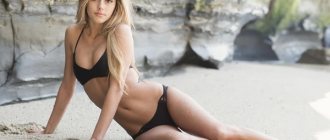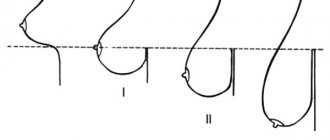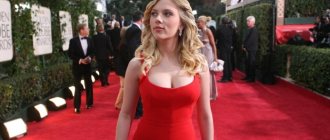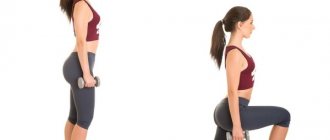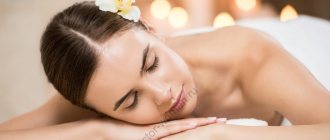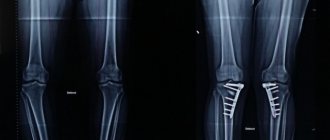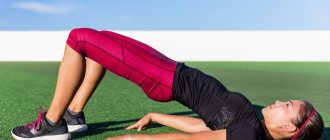Greetings! This article is about lengthening your legs naturally. This may be relevant for models for whom, due to their profession, it is important to have long legs. Also for people with closing growth plates, since the growth plates on the legs are the last to close. Many special exercises and techniques have already been invented to lengthen the legs. Here are 9 of the most famous ones.
In addition to the text version, watch the video with examples at the end of the article.
Kicking Jumping Interval running Inversion training Swimming Band stretching Weight stretching Riding with a raised saddle Stretching exercises
Bones grow under the influence of 2 types of exercises: “impact” and “stretching”. Do them together for better results. Let's start with the drums.
Impact training creates microdamage to the bones and irritates the growth plates on the legs. At the site of microdamage, new tissue is formed and the bones lengthen. And irritated growth zones also activate growth.
I included kicking, jumping and running as percussion. Next, we will briefly look at them individually.
Kicks
Suitable strikes include punching the punching bag, the opponent, or the air.
Two types of strikes work well: strikes with the instep of the foot and the base of the foot.
. Foot strikes are strikes with the portion of the leg from the ankle to the toes. In taekwondo, such a blow is called “dolyo chagi.” Heel kicks are horizontal or vertical kicks with the heel of the foot. Do both. Aim at different points: the head, torso or legs.
Beat for 10-15 minutes at a fast pace daily or every other day.
Diagnosis of asymmetry of the lower extremities
Examination of children with leg length discrepancies at the Ikhilov Complex medical center takes up to 3-4 days.
First day – first visit to the clinic
Directly from the airport or (if desired) after hotel accommodation, the patient is sent for an initial consultation with a leading orthopedic surgeon. The doctor studies the medical history, conducts a physical examination and prescribes the necessary studies to clarify the diagnosis.
Second day – examination in our clinic
The second day of diagnosis is devoted to various studies. Their list may include various diagnostic procedures.
- Radiography is an X-ray examination that allows one to assess the severity of length asymmetry and differentiate pathology from other diseases with similar symptoms, and distinguish anatomical leg length discrepancy from a functional one.
- Computed tomography is an even more accurate x-ray diagnostic method that allows you to fully visualize the bone structures of the lower extremities in a three-dimensional coordinate system. Compared to traditional X-rays, CT provides more accurate diagnostic results.
- Low-dose digital radiography is a variant of computed tomography, specially created for examining young patients and allowing them to significantly reduce the radiation dose they receive during the examination.
- Ultrasound examination of the length of the leg bones (the accuracy of this measurement is almost the same as that of radiography).
Third day – choosing a correction method
During the third day, the leading orthopedist convenes a medical consultation. Doctors collectively analyze diagnostic data and select the most promising method for correcting leg asymmetry.
Jumping
Next in line are the jumps. They also make the legs grow by creating microcracks and irritating the growth zones. I offer 3 options for jumping.
Jump rope
One of the most affordable growth trainers.
Jump rope for 5-10 minutes at an intense pace every day or every other day.
Plyometrics
In addition to jump rope, consider plyometrics, which are specialized jumping workouts. Jumping jacks or high jumps are the right choices. This is more difficult than jumping rope, but the effect is also greater. Try to devote some time to plyometrics.
Trampoline
The third way to jump is to buy yourself a home trampoline or go to trampoline clubs. Unlike the first two methods, you can jump on a trampoline for hours. It's easy and very attractive for children. There will also be an effect on growth if you jump for 20–30 minutes every day or every other day.
Leg length differences. Orthopedic doctor, candidate of medical sciences Alexey Viktorovich Mozgunov.
December 03, 2019
Magazine "Family Health"
Leg length difference, or, for short, Limb Length Discrepancy, is a fairly common condition. Thus, according to one study, 32% of 600 conscripts aged 18 were diagnosed with RDN. However, those patients who have RDN, as a rule, are not aware of this, and the announced diagnosis causes them surprise and bewilderment. In domestic medicine, the diagnosis “shortening of the lower extremity due to the thigh and/or lower leg” is quite firmly rooted. However, it does not reflect the full breadth of the spectrum of this condition. It is believed that some extraordinary reason is necessary for a difference in leg length to occur. For example, a fracture of the femur or leg bones - incorrectly healed along the length with shortening (in a plaster cast), and in rare cases with lengthening (skeletal traction or external fixation device). However, much more often, a fracture of these bones, especially located near their articular ends, leads to a local increase in blood flow and forced bone growth due to the stimulation of the so-called growth plates. Another relatively common condition in childhood, acute hematogenous osteomyelitis, with a pronounced purulent process, often contributes to inhibition of the adjacent growth zone and the development of limb shortening, but in some cases (for example, after surgical treatment) it also leads to lengthening. However, most often in practice the so-called idiopathic (that is, of unknown cause) RDN occurs, which will be discussed below. The reasons are assumed to be different - some kind of hidden childhood bone injury or a previous infectious process, which could cause “imperceptible” damage to the growth zone (or zones). There is also a theory that inhibition of growth zones occurs against the background of normal physiological development of the lower extremities in children, which “rapidly” occurs during the first 5 years of life. During this time, the child’s lower limbs change their shape twice - from “O”-shaped to “X”-shaped (usually by 11-12 months), and then to the so-called. “correct” (by age 5). This happens at the level of the knee joints, and mainly at the level of the upper legs, which are thus in a state of “chronic stress”. In a number of children, this “overload” leads to “mild” inhibition of the growth zone located there with the development of shortening, and in an even smaller number of children (0.03%), the process goes further with the development of the so-called Blount’s disease. This theory well explains the reason why idiopathic RDN most often exists due to the bones of the lower leg, and also the fact that it is detected after 5 years of age (when the shortening “accumulates”). Parents bring such children to an orthopedist, as a rule, at school age, and they come about suspicion of poor posture, scoliosis, flat feet, and impaired gait. However, it also happens that for the first time RDN is detected in adult patients who consult a doctor about pain in the feet (like a “heel spur”, in the area of the “root” of the foot) or back. The reason for this is that shortening the lower limb leads to an imbalance of the entire musculoskeletal system of a person - from the feet to the spine. The most common clinical variants of RDN are the following. Most often, RDN leads to a shift in the center of gravity of the body towards the shortened limb, where, due to overload, flat feet are formed. Flat feet, in turn, “strengthens” the anatomical shortening of the limb with a functional one - by reducing the height of the longitudinal arch of the foot. On the shortening side, a tilt (distortion) of the pelvis occurs with the formation of lumbar scoliosis. Next, a “balancing” counter-arch is formed in the upper thoracic spine, resulting in “S”-shaped scoliosis of grades I-II. The rotation of the vertebrae (torsion) characteristic of scoliosis can lead to increased thoracic kyphosis (anterior flexion), as well as a cosmetically noticeable change in the shape of the chest. Some children unconsciously try to eliminate the imbalance that has arisen by “turning on” a number of adaptive mechanisms. Some “pull their toes” and walk “on tiptoes” on the shortening side, thus preventing a shift in the center of gravity. With a slight shortening (0.5 cm), this eliminates pelvic distortion and slows down the development of scoliosis. However, clinically, the smoothness of gait is impaired. Other children try to put more weight on the opposite leg. As a result, flat feet are formed on the other (“long”) side, which functionally compensates for RDN. But this compensation is only possible with a slight shortening. Some children, more flexible than others, form so-called recurvation (hyperextension) in the knee joint on the side opposite to shortening, which also leads to functional elimination (complete or partial) of RDN. However, this results in a cosmetic defect and complaints of joint pain. Diagnosis of RDN occurs during a comprehensive orthopedic examination of the patient (from head to toe). The type and degree of shortening is determined using special clinical tests. Measurements using a centimeter tape, oddly enough, often turn out to be difficult and therefore not accurate - for example, with excess fat deposits, when it is sometimes impossible to palpate the necessary bone protrusions, and also due to the behavioral characteristics of children (they perceive this palpation as tickling ). Usually the RDN is about 0.5-1 cm, less often 1.5 cm. Even less often, the shortening of the limb is 2-3 cm, often not only due to the lower leg, but also due to the thigh. Why is RDN dangerous? First of all, those orthopedic diagnoses to which it leads. Thus, flat feet, if not corrected, can cause pain in the feet and legs already in children from 5-6 years of age. Scoliosis can lead to back pain already in adolescence, and in addition it also has a cosmetic aspect (“crooked back”, asymmetrical chest structure). Hyperextension of the knee joint (recurvation) can cause pain and cosmetic concerns. In addition, the danger also lies in the fact that RDN, and therefore the degree of conditions accompanying it, can increase until the end of children’s growth, that is, up to 15-18 years. It is believed that shortening up to 3 cm does not require surgical treatment and should be corrected conservatively. However, in practice, patients do not tolerate RDN correction well, starting from 2 cm. This implies the importance of preventing the progression of existing shortening. Pain in the feet and back that appears in adulthood, seemingly “suddenly”, is often difficult to treat 39 by orthopedists, and may also be caused by “orthopedic imbalance” that arose against the background of RDN existing since childhood. Treatment of RDN and accompanying orthopedic conditions occurs in the following main areas: • elimination of RDN (heel splint on the shortening side); • correction of existing flat feet (orthopedic insoles); • prevention of increasing the degree of scoliosis (strengthening the muscular “corset” of the back through massage, physical therapy, dosed use of posture correctors). In addition, in a growing child’s body, it is also possible to have a local effect on the affected growth zone through paraffin applications of the “wrap” or “wrapping” type, as well as electrophoresis (with aminophylline, papaverine), aimed at improving blood circulation. The goal of such treatment is to slow down the increase or even reduce the RDN. In this case, of course, dynamic observation by an orthopedist is also necessary, especially during periods of growth spurts. Thus, suspicion of gait disturbance, flat feet, poor posture or scoliosis requires a mandatory qualified examination by an orthopedist. Unfortunately, it is not uncommon for these conditions to be treated without correcting the RDN that caused them, which sometimes negates all efforts. But, in addition, there are cases of erroneous (so-called “false”) diagnosis of RDN with the prescription of “appropriate” treatment, which can lead to “imbalance” of a healthy body, and in addition, cause emotional distress for the child and his relatives, loss of their personal time.
Share on social networks
Interval running
Closes the list of running activities. In principle, walking is also suitable, but during running the load on the bones is several times greater. For our purpose, running is preferable. The greater the load, the more irritated the bones.
Interval running or running with acceleration has proven itself to be excellent. The idea is to alternate moderate running with sprints.
. For example, run for 20 seconds at an easy pace and 10 seconds at a fast pace. Alternate and continue for 5-10 minutes. Exercise a couple of times a week.
We are done with impact exercises and move on to stretching exercises. Stretching ones will enhance the percussion effect. In other words, if the leg bones are first damaged and then stretched, expect a synergistic effect.
I included inversions, stretching with bands and weights, as well as cycling with a raised saddle, swimming pool, and stretching exercises. Let's go in order.
Advantages and disadvantages
Increasing height with the help of surgery has only one, but quite a big plus is that you can “grow” 16 centimeters.
Well, there are, of course, much more disadvantages of this procedure. The main ones include:
- Complications. We have already mentioned them a little higher.
- Long lasting pain. You will feel it from the moment of surgery and even during the rehabilitation period. Therefore, she will be practically inseparable from you for several months.
- Time. You will have to be quite bored and seem to be isolated from the outside world while you are in the clinic and then when you need to restore your body.
- High price. Not everyone can pay for this procedure. For most of the population it is completely inaccessible.
As you can see, it is quite possible to increase height with the help of surgery, but is it worth your money, time, health and limitless patience? Maybe it’s easier to wear heels or some kind of platform shoes than to suffer from pain and waste your time on such a complex procedure?
Swimming
The force of gravity, which constantly attracts the earth on land, is reduced in water. This makes it easier for the body to grow. In addition, in the water you will have to stretch more often, including pulling your legs, to stay afloat and not drown.
To increase height, 2 types of swimming are more effective: crawl and back crawl.
. However, they require a lot of strength, so you won’t be able to swim for a long time. At least at first. In between crawl approaches, use breaststroke or something else. For example, change 20 seconds of freestyle crawl to 40 seconds of breaststroke and vice versa.
Frequency: at least 3 times a week for 30-60 minutes.
Some kind of wrong oversize
Those with short stature need to be especially careful with excess volume. For example, short oversized down jackets absolutely fall into the “sanctioned” category. They will make your silhouette heavier and will certainly visually steal a few precious centimeters.
If I were you, I would take a closer look at long coats, raincoats and down jackets. Especially if the models are fitted. Although a straight cut will also look good. Color in this case is unimportant, and this is a definite plus.
You can safely give raincoats, coats, jackets with large details, for example with voluminous patch pockets, to a friend if she is taller than you. Thumbelina girls should not wear such models.
Photo: Shutterstock.com
Stretching with weights
A fourth leg stretching technique—an old and well-respected one—is sitting with weights. The mechanism of operation is similar to tourniquets, that is, the legs are constantly stretched and become longer over time.
To sit with weights, you need a high chair or table so that your feet do not touch the floor. Weights here range from 1 kg and more. Put on weights, sit down and sit for 30-60 minutes every day.
Try alternating this technique with tourniquets: for example, stretch with tourniquets one day, and weights the other day.
Structure of the lower leg
So, the lower leg is an intermediate formation, which consists of the following structures:
- Tibia. A tubular bone that has two growth zones located slightly central to the diaphyses. The diaphysis is the extension of the bone at one end. The joint, ligaments, and periarticular bursae are usually attached to it. The diaphysis is covered with cartilage tissue, which ensures reliable attachment of the ligamentous-articular apparatus to the bone.
- The fibula is also tubular, but of smaller diameter. It is located lateral to the tibia. This bone also has two growth zones near the diaphysis and a large number of ligaments.
- Knee-joint. A complex articulation that consists of the articular surfaces of three bones. It is a mistake to think that stretching it will lead to lengthening of the legs. Constant mechanical stretching of the knee joint ligaments will only lead to habitual instability.
- Ankle joint. Its basis is the talus bone, on which the ankles of the tibia and fibula rest.
- The calf muscles are one of the anatomical structures whose length is easiest to change. About a million exercises have already been invented and developed for stretching, pumping and shaping the muscles of the lower leg.
- Ligaments and tendons are dense, hard-to-change structures that hold bones and muscles together. It is possible to stretch ligaments at home and in the gym, but this requires a little more time than working with muscles.
Stretching exercises
Stretching exercises are needed more to stretch the muscles, not the bones. Which is also important, since relaxed and stretched muscles allow bones to grow unhindered.
As an example, I will give splits and yoga asanas.
for legs. Hold each exercise for 30–60 seconds. You can sit on the splits for longer. It is advisable to repeat it daily or several times a week.
Watch video on YouTube
That's all the leg lengthening exercises for today. In conclusion, I will say 2 things.
1. Consult your doctors. The mentioned exercises are not always allowed to be performed in case of health problems.
2. Create an individual schedule for yourself. As you noticed, I always advised exercising every day or every other day. But this does not mean that everything needs to be done at once. Vary your exercises. Gradually increase the load. Rest when necessary.
Thank you for your attention. I wish you success!
Best regards, Vadim Dmitriev
Selection of wardrobe items
As a rule, representatives of the fair sex are very afraid of lengthening their legs through surgery. And there is nothing surprising here, because this procedure is very expensive, painful and involves a long rehabilitation period . However, you can visually enlarge your legs through well-chosen outfits.
To make them look longer, it is advisable to wear plain trousers with vertical stripes. Pants equipped with horizontal patterns and prints visually plump the figure, and make the lower limbs shorter, so it is recommended to avoid using such things.
In addition, it is necessary to select the right models. The length of the trousers should be sufficient so that there is no gap between shoes and clothing. Cropped options and breeches are great for long-legged beauties because they visually make the legs appear shorter.
If a lady uses tights, then their color should match the shade of the shoes. For example, it is better to combine black tights with black shoes. In this case, you can immediately notice the lengthening of the lower limbs. It is not advisable to purchase dresses and sets of outfits that divide the silhouette into a couple of parts, for example, a dress with a blue bodice and a red skirt. For a similar reason, it is recommended to avoid using wide and massive belts, since they also divide the silhouette into separate parts. It is better to opt for elegant and thin products.
It is important to choose the right skirt. Long skirts shorten your legs, so girls with short legs should not wear them. Pencil skirts are great for this situation. They give a slim figure and allow you to achieve good proportions by lengthening your legs.
To visually increase your height, you need to choose the right dress. It is advisable to prefer monochromatic models, without contrasting ornaments and patterns. Large stripes and spots, of course, draw attention to them, but at the same time they shorten the legs.
The simplest and most popular shoe option is shoes with high heels. A lady wearing such shoes becomes more graceful and taller, but she also needs to learn how to walk in such shoes so as not to look ridiculous or even funny. In addition, shoes must be selected in accordance with the outfit to avoid excessive contrast.
